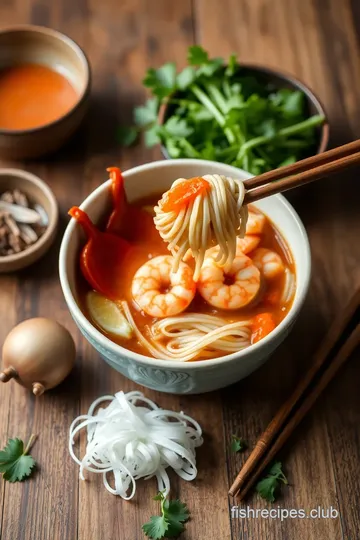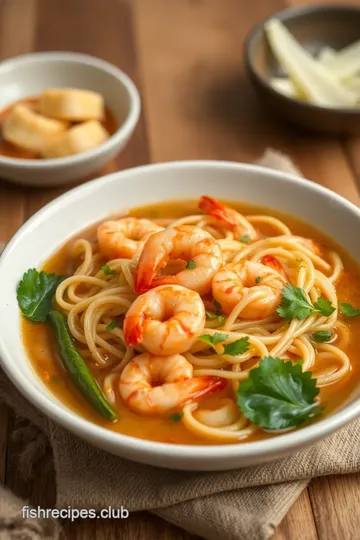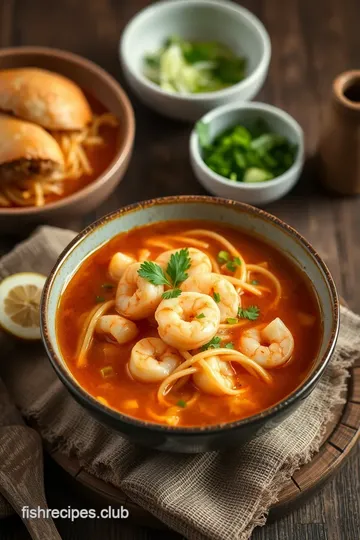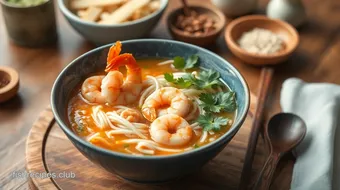Quick Shrimp Rice Noodle Soup
Craving something warm and satisfying? This Quick Shrimp Rice Noodle Soup is packed with flavor! Join me in creating this comforting dish bursting with ginger and lime.

- look into into Comfort with Quick Shrimp Rice Noodle Soup
- What’s the Deal with This Soup?
- Health Meets Happiness
- Wrap It Up
- Essential Ingredients Guide for Your Kitchen
- Professional Cooking Method
- Pro Tips & Secrets: The Inside Scoop
- Perfect Presentation: Make It Instagram-Worthy
- Storage & Make-Ahead: Meal Prep Magic
- Creative Variations: Time to Get Wild!
- Complete Nutrition Guide: Eating Well
- Expert FAQ Solutions: Your Questions Answered
- Recipe Card
look into into Comfort with Quick Shrimp Rice Noodle Soup
Have you ever had one of those nights where you just want to cozy up with a bowl of something warm and comforting but don’t want to spend hours in the kitchen? i totally get that! picture this: a delightful bowl of quick shrimp rice noodle soup that’s both comforting and full of flavor, simmering away in just 25 minutes .
Honestly, it’s a bit like a hug in a bowl. i remember the first time i whipped this up; i was exhausted after a long day, but just a whiff of that ginger-garlic broth brought me right back to life.
What’s the Deal with This Soup?
So, what’s the background on this dish? well, this cozy soup has its roots in southeast asian cuisine , a world filled with bold flavors and fresh, aromatic ingredients.
It captures the essence of those cultures, with simple ingredients coming together to create a symphony of deliciousness. you see, rice noodles and shrimp pair perfectly, and when you toss in ginger and garlic, it’s like a flavor party in your mouth.
These days, this rice noodle soup is a go-to for many families, especially perfect for busy weeknights. why? it’s quick , easy , and customizable —the trifecta of family meals!
Those 10 minutes of prep and 15 minutes of cooking is all you need to serve up a warm, satisfying bowl.
And let’s talk about cost—this wholesome soup is friendly on the wallet, making it a great option for family dinners without breaking the bank.
Health Meets Happiness
Now, let’s get down to why we should be excited about this recipe. first off, the health benefits are pretty impressive.
Shrimp is a protein-rich food , loaded with nutrients like selenium and vitamin b12. paired with the fresh snap peas (or bok choy if you fancy) in a low-sodium broth ? you can feel good about what you’re serving up.
Plus, it’s a low-calorie soup recipe packed with vibrant veggies, making it perfect if you’re trying to eat light and healthy.
But it doesn’t stop there! this soup shines not just on regular weekdays but also on special occasions. think of a cozy dinner date or a gathering with friends—this dish perfectly balances flavors in soup while feeling like a fancy dish without the fuss.
Pairing it with fresh herbs like cilantro brings a pop of color and flavor, giving each bowl that comfort food vibe that we all crave from time to time!
Wrap It Up
Ready to roll into the kitchen? this quick meal prep idea is calling your name! whether you're looking for an easy shrimp recipe or a simple soup recipe to warm your heart, you’ve got options here.
With a cup of that ginger garlic broth simmering and rice noodles cooking, you’ll have a delightful meal on the table before you know it.
So, without further ado, let’s gather those fresh ingredients to create your very own homemade shrimp soup ! trust me; you’ll want to keep this gem in your recipe rotation.
It's not just a meal; it's an experience—an aromatic embrace of flavors waiting for you.
Now, let’s check out what you’ll need to get started!

Essential Ingredients Guide for Your Kitchen
Cooking can feel overwhelming, but having the right essential ingredients on hand will make it a breeze. if you're tackling a quick shrimp rice noodle soup or any other meal, understanding your ingredients is key.
Let’s break it down into bite-sized pieces, shall we?
Premium Core Components
First up, we need to talk about the premium core components of your dish. this section can sometimes feel like we're diving into the land of food snobbery, but don’t fret! here’s how to keep it straightforward.
Detailed measurements are crucial. for example, if a recipe calls for 4 cups (960 ml) of broth, don’t be shy about using that measuring cup! it’s your best friend here.
And speaking of friendships, keep an eye out for quality indicators. fresh shrimp should be pink with a glossy sheen – anything less might just spoil the fun of your swift shrimp soup recipe .
Storage guidelines are also a must. remember, pretty much everything has a shelf life. fresh herbs can hang around for about a week if you keep them wrapped in a damp paper towel, whereas rice noodles can last a lot longer in an airtight container.
To keep your ingredients fresher longer, always check the label—don't throw away your hard-earned cash on expired goods!
Signature Seasoning Blend
Moving on to the pièce de résistance - your signature seasoning blend! this is where your creativity can truly shine.
Think about essential spice combinations you can whip up at home. a classic like garlic and ginger is a match made in heaven for our ginger garlic broth in this soup.
Throw in some fresh lime juice, and boom! you’re balancing flavors like a pro.
Herb selection is big too. fresh cilantro and basil elevate your dish into another dimension. honestly, there's something magical about the aroma of fresh herbs wafting through the kitchen.
And if you want to shake things up, try regional variations. eastern-style onion oil or fermented sauces provide delicious twists on traditional flavors!
Smart Substitutions
Unless you’ve set your heart on a top-shelf recipe, smart substitutions can save the day! maybe you don’t have shrimp.
No problem, my friend! toss in firm white fish or even tofu for a vegetarian noodle soup. and if you need to make dietary modifications – like cutting out gluten or lowering sodium – you’ve got options.
Emergency replacements are your lifeline too! Don’t have soy sauce? Tamari saves the day. This kind of flexibility can make prepping your easy shrimp recipes a whole lot less stressful.
Kitchen Equipment Essentials
Okay, let’s switch gears to some kitchen equipment essentials . you really don’t need fancy gadgets to shine in the kitchen! a simple large pot or a dutch oven can do wonders when you're making a broth-based dish like our shrimp noodle soup.
If you've got a wooden spoon, you're golden!
Additionally, a good knife and a cutting board are handy for chopping fresh ingredients. if you can’t afford a fancy knife, just remember that a little bit of elbow grease goes a long way.
And don’t forget about storage solutions! airtight containers can keep your ingredients fresh and organized, which is essential when you’re meal prepping for busy nights.
Wrapping It Up
So there you have it—all the essential info you need for tackling your next cooking adventure, especially when bringing a quick and flavorful shrimp rice noodle soup to life! with good ingredients and a little creativity, you can transform simple elements into mouthwatering dishes.
Stay tuned for the instructions that will guide you step-by-step through making this cozy comfort food that will have everyone begging for seconds! happy cooking, and let’s get that broth bubbling!
Professional Cooking Method
Let’s talk about the world of professional cooking and how you can bring a touch of that finesse to your home kitchen.
Whether you’re whipping up a comforting quick shrimp rice noodle soup or a gourmet feast, a little organization goes a long way.
Trust me when i say it all starts with some essential preparation steps.
Essential Preparation Steps
First off, let’s dig into mise en place. this fancy french term? it just means having everything ready before you start cooking.
Chop your vegetables, measure out your ingredients, and lay them all out. it saves you from the last-minute scramble, so you can focus on creating delicious dishes without the stress.
Now, onto time management. plan your cooking timeline. for instance, if you're making that shrimp soup, you want to have everything prepped before you even turn on the stove.
Speaking of which, it usually takes about 25 minutes total to get that masterpiece on the table.
As for organization strategies , keep your workspace tidy. clean as you go. trust me, it makes the whole cooking experience a lot more enjoyable and less chaotic.
Oh, and don’t forget safety considerations! keep those chopping knives away from kids and always be mindful of handling hot pots.
Nobody needs a visit to the er for a cooking mishap.
Step-by-Step Process
Now, let's get down to business. Here’s your step-by-step process for making that shrimp noodle soup:
- Heat olive oil in a large pot over medium heat. Toss in 3 cloves of minced garlic and the sliced ginger . You’ll want to sauté them until fragrant—this takes around 1 minute.
- Next, add 4 cups of your low-sodium broth and bring it to a simmer. The cool thing is the broth just needs a few moments to mingle with all those flavors. Adding 2 tablespoons of soy sauce and the juice of 1 lime will really brighten it up!
- In another pot, cook 8 ounces of rice noodles according to package instructions. You’re looking at about 3- 4 minutes. Make sure to drain and set aside.
- Time to add the shrimp. Toss in your 1 pound of shrimp into that simmering broth. They cook up super fast—you’re talking about 3- 4 minutes here until they’re pink and pretty.
- Stir in 1 cup of snap peas or the green goodies of your choice and let it simmer for another 2 minutes.
- Finally, it’s time to assemble. Ladle that aromatic broth over some noodles, garnish with fresh cilantro and sliced green onions, and voilà!
Expert Techniques
Getting a bit technical here, let’s discuss some expert techniques . one of the critical steps? timing! you can easily go from perfectly cooked shrimp to rubbery little things if you turn your back.
Keep an eye on them!
When it comes to quality checkpoints, taste as you go. If the broth isn’t singing to you, add more lime or soy sauce until it’s just right.
If you find yourself in a jam, say you’ve overcooked the shrimp—don’t panic! Pull them out and let them rest while you finish up the soup. It helps keep them tender.
Success Strategies
Let’s wrap this up with some success strategies. Avoid common mistakes, like overcrowding your pot. You want enough room for those shrimp to really soak in that flavorful broth without getting mushy.
Something to keep in mind is quality assurance. use fresh ingredients! fresh herbs can elevate your bowl. and hey, don’t shy away from making a big batch.
This is a terrific meal prep dish. you can keep the broth and noodles separate for the next day. just reheat, and you’re golden!
So there you have it: cooking is an art. whether it's simple soup recipes like this quick shrimp rice noodle soup or something fancier, the key lies in your prep, timing, and an eye for detail.
As we dive deeper into cooking methods, I’ve got more additional information coming up! Stay tuned for tips on fine-tuning your skills and more delicious recipes!

Pro Tips & Secrets: The Inside Scoop
Let's dive into the world of quick shrimp rice noodle soup and sprinkle in some insider tips that’ll make your cooking a breeze.
Honestly, every chef has their lil' secrets, right? here are some of mine:
-
Timing is key: when you’re making this soup, keep an eye on the shrimp. they only need 3- 4 minutes in that bubbling broth.
Any longer, and they’ll become rubbery. trust me, nobody wants an overcooked shrimp in their soup!
-
Sauté like a pro: get that garlic and ginger sizzling in the pot before you toss in the broth. it’s like putting on the best concert before your favorite band comes out.
The aroma? to die for!
-
Elevate the flavor: need an extra oomph? a splash of fish sauce (if you're cool with it) takes the flavor to a whole new level.
And hey, don’t shy away from squeezing in some extra lime juice. it brings all those flavors to life!
-
Dress to Impress: Let's talk presentation. It’s all about those fresh herbs and pretty garnishes. A sprinkle of cilantro or sliced green onions not only looks pretty but also enhances the flavor profile, balancing everything out in your bowl!
Perfect Presentation: Make It Instagram-Worthy
Alright, so you nailed the recipe—now let’s make it look as good as it tastes! Here are some simple yet effective tips for plating your rice noodle soup :
-
Layer up: start with the noodles at the bottom, then add the shrimp on top, and showcase those vibrant veggies.
This layering not only protects the noodles from sogginess but also creates a visual treat.
-
Garnish Game Strong: Fresh herbs can be a game changer. Adding cilantro or basil right before serving gives an aromatic punch to your soup. Plus, they add a splash of color.
-
Go Big with Lime: Placing lime wedges on the side not only invites a splash of freshness but adds that needed pop of color.
Storage & Make-Ahead: Meal Prep Magic
Got leftovers? Here’s how to store that homemade shrimp soup like a pro:
-
Separate and conquer: always store your broth and noodles separately. this way, your noodles don’t soak up all that goodness and turn mushy when you reheat.
They’ll be just as delightful as the first time!
-
Reheat with Care: When it’s time to reheat, do so slowly on low heat. If you microwave it (gasp!), add a splash of water to keep the soup's integrity.
-
Freshness Duration: Enjoy your soup fresh for about 3-4 days in the fridge. Just be sure to finish those noodles sooner rather than later.
Creative Variations: Time to Get Wild!
Feel like switching things up? The beauty of soup is its customizability .
-
Add Variety: Swap shrimp for firm tofu for a vegetarian spin or toss in mushrooms for that earthy flavor.
-
Seasonal Goodness: Use whatever veggies are in season. Think bright bell peppers or even some leafy greens for added nutrition and color .
-
Bring the Heat: Don’t shy away from adding a kick! Red pepper flakes or a drizzle of sriracha makes a big difference for those who like it spicy.
Complete Nutrition Guide: Eating Well
This isn’t just comfort food; it’s nutrient-rich goodness in a bowl! Each serving gives you a decent dose of protein and fiber. Here’s the lowdown:
-
Balanced Approach: This soup is not just about flavor; it's got your protein and healthy carbs from the noodles. And it’s fairly low-calorie, perfect for easy weeknight dinners!
-
Watch the Sodium: If you're looking for low-sodium soup options , stick to our broth choice—it’s the best way to control your sodium intake.
Expert FAQ Solutions: Your Questions Answered
First time making this soup? No worries! Here’s a quick troubleshooting guide:
-
Shrimp wasn’t cooked: If they’re still translucent, just pop them back in the broth for another minute or two—no biggie.
-
Too salty? A splash of water or more veggies can help balance the flavor.
-
Want it creamier? Throw in some coconut milk for a rich twist, and you’ll be swimming in deliciousness!
Wrapping up, i encourage you to get in that kitchen and whip up a bowl of quick shrimp rice noodle soup .
It’s delicious, nourishing, and perfect for any night of the week. trust me, once you’ve made this comforting dish, you’ll be coming back for more.
Happy cooking!

Quick Shrimp Rice Noodle Soup Card

⚖️ Ingredients:
- 4 cups low-sodium chicken or vegetable broth
- 1 tablespoon olive oil
- 3 cloves garlic, minced
- 1 inch piece ginger, peeled and sliced
- 2 tablespoons soy sauce
- 1 tablespoon fish sauce (optional)
- Juice of 1 lime
- 8 ounces rice noodles
- 1 pound large shrimp, peeled and deveined
- 1 cup snap peas or bok choy, trimmed and sliced
- 1/4 cup fresh cilantro, chopped
- Sliced green onions, for garnish
- Lime wedges, for serving
🥄 Instructions:
- Step 1: Heat olive oil in a large pot over medium heat.
- Step 2: Sauté minced garlic and ginger until fragrant (about 1 minute).
- Step 3: Add chicken or vegetable broth, soy sauce, fish sauce, and lime juice. Bring to a simmer.
- Step 4: In a separate pot, cook rice noodles according to package instructions.
- Step 5: Drain and set aside.
- Step 6: Once the broth is simmering, add shrimp to the pot.
- Step 7: Cook until the shrimp are pink and opaque (about 3-4 minutes).
- Step 8: Stir in snap peas or bok choy.
- Step 9: Simmer for an additional 2 minutes until vegetables are tender yet crisp.
- Step 10: Divide cooked noodles among serving bowls.
- Step 11: Ladle hot broth and shrimp over the noodles.
- Step 12: Top with fresh cilantro and sliced green onions.
- Step 13: Serve with lime wedges for squeezing over the soup.
Previous Recipe: Ultimate Broiled Salmon with Miso Glaze | 18 Minutes of Flavor Bliss
Next Recipe: How to Bake Salmon with Panko Crust & Garlic Flavor: A Delicious Secret!
